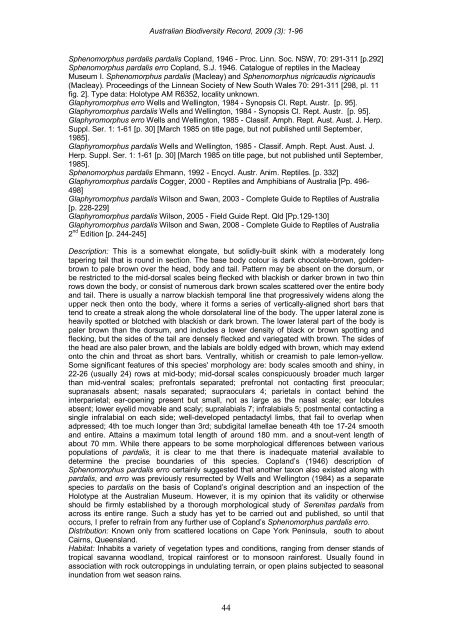AUSTRALIAN BIODIVERSITY RECORD - Calodema
AUSTRALIAN BIODIVERSITY RECORD - Calodema
AUSTRALIAN BIODIVERSITY RECORD - Calodema
Create successful ePaper yourself
Turn your PDF publications into a flip-book with our unique Google optimized e-Paper software.
Australian Biodiversity Record, 2009 (3): 1-96<br />
Sphenomorphus pardalis pardalis Copland, 1946 - Proc. Linn. Soc. NSW, 70: 291-311 [p.292]<br />
Sphenomorphus pardalis erro Copland, S.J. 1946. Catalogue of reptiles in the Macleay<br />
Museum I. Sphenomorphus pardalis (Macleay) and Sphenomorphus nigricaudis nigricaudis<br />
(Macleay). Proceedings of the Linnean Society of New South Wales 70: 291-311 [298, pl. 11<br />
fig. 2]. Type data: Holotype AM R6352, locality unknown.<br />
Glaphyromorphus erro Wells and Wellington, 1984 - Synopsis Cl. Rept. Austr. [p. 95].<br />
Glaphyromorphus pardalis Wells and Wellington, 1984 - Synopsis Cl. Rept. Austr. [p. 95].<br />
Glaphyromorphus erro Wells and Wellington, 1985 - Classif. Amph. Rept. Aust. Aust. J. Herp.<br />
Suppl. Ser. 1: 1-61 [p. 30] [March 1985 on title page, but not published until September,<br />
1985].<br />
Glaphyromorphus pardalis Wells and Wellington, 1985 - Classif. Amph. Rept. Aust. Aust. J.<br />
Herp. Suppl. Ser. 1: 1-61 [p. 30] [March 1985 on title page, but not published until September,<br />
1985].<br />
Sphenomorphus pardalis Ehmann, 1992 - Encycl. Austr. Anim. Reptiles. [p. 332]<br />
Glaphyromorphus pardalis Cogger, 2000 - Reptiles and Amphibians of Australia [Pp. 496-<br />
498]<br />
Glaphyromorphus pardalis Wilson and Swan, 2003 - Complete Guide to Reptiles of Australia<br />
[p. 228-229]<br />
Glaphyromorphus pardalis Wilson, 2005 - Field Guide Rept. Qld [Pp.129-130]<br />
Glaphyromorphus pardalis Wilson and Swan, 2008 - Complete Guide to Reptiles of Australia<br />
2 nd Edition [p. 244-245]<br />
Description: This is a somewhat elongate, but solidly-built skink with a moderately long<br />
tapering tail that is round in section. The base body colour is dark chocolate-brown, goldenbrown<br />
to pale brown over the head, body and tail. Pattern may be absent on the dorsum, or<br />
be restricted to the mid-dorsal scales being flecked with blackish or darker brown in two thin<br />
rows down the body, or consist of numerous dark brown scales scattered over the entire body<br />
and tail. There is usually a narrow blackish temporal line that progressively widens along the<br />
upper neck then onto the body, where it forms a series of vertically-aligned short bars that<br />
tend to create a streak along the whole dorsolateral line of the body. The upper lateral zone is<br />
heavily spotted or blotched with blackish or dark brown. The lower lateral part of the body is<br />
paler brown than the dorsum, and includes a lower density of black or brown spotting and<br />
flecking, but the sides of the tail are densely flecked and variegated with brown. The sides of<br />
the head are also paler brown, and the labials are boldly edged with brown, which may extend<br />
onto the chin and throat as short bars. Ventrally, whitish or creamish to pale lemon-yellow.<br />
Some significant features of this species' morphology are: body scales smooth and shiny, in<br />
22-26 (usually 24) rows at mid-body; mid-dorsal scales conspicuously broader much larger<br />
than mid-ventral scales; prefrontals separated; prefrontal not contacting first preocular;<br />
supranasals absent; nasals separated; supraoculars 4; parietals in contact behind the<br />
interparietal; ear-opening present but small, not as large as the nasal scale; ear lobules<br />
absent; lower eyelid movable and scaly; supralabials 7; infralabials 5; postmental contacting a<br />
single infralabial on each side; well-developed pentadactyl limbs, that fail to overlap when<br />
adpressed; 4th toe much longer than 3rd; subdigital lamellae beneath 4th toe 17-24 smooth<br />
and entire. Attains a maximum total length of around 180 mm. and a snout-vent length of<br />
about 70 mm. While there appears to be some morphological differences between various<br />
populations of pardalis, it is clear to me that there is inadequate material available to<br />
determine the precise boundaries of this species. Copland’s (1946) description of<br />
Sphenomorphus pardalis erro certainly suggested that another taxon also existed along with<br />
pardalis, and erro was previously resurrected by Wells and Wellington (1984) as a separate<br />
species to pardalis on the basis of Copland’s original description and an inspection of the<br />
Holotype at the Australian Museum. However, it is my opinion that its validity or otherwise<br />
should be firmly established by a thorough morphological study of Serenitas pardalis from<br />
across its entire range. Such a study has yet to be carried out and published, so until that<br />
occurs, I prefer to refrain from any further use of Copland’s Sphenomorphus pardalis erro.<br />
Distribution: Known only from scattered locations on Cape York Peninsula, south to about<br />
Cairns, Queensland.<br />
Habitat: Inhabits a variety of vegetation types and conditions, ranging from denser stands of<br />
tropical savanna woodland, tropical rainforest or to monsoon rainforest. Usually found in<br />
association with rock outcroppings in undulating terrain, or open plains subjected to seasonal<br />
inundation from wet season rains.<br />
44

















